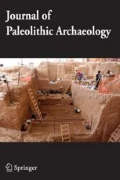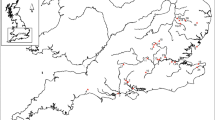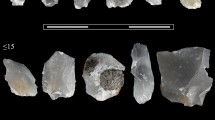Abstract
Initially excavated in the early twentieth century, La Ferrassie is one of the most important sites for the Middle Paleolithic of Western Europe. Aside from the numerous Neanderthal remains found there, the stone artifacts recovered from the site are featured prominently in discussion and debates of Mousterian variability. Recent renewed excavation of the site, however, suggests a considerable preference in the kinds of stone artifacts saved during the initial excavation. Here, we assess the nature and extent of this selection and its effects on the final collection. Results indicate that large, complete, retouched pieces were preferentially retained by the original excavators, and that the artifact collection available for study represents only 2–3% of the original lithic assemblage present in the deposits. This has significant implications for early interpretations of Mousterian industries that were based on such collections and their potential analytical value.







Similar content being viewed by others
References
Ahler, S. A. (1989). Mass analysis of flaking debris: studying the forest rather than the tree. Archeological Papers of the American Anthropological Association, 1(1), 85–118.
Ami, H. (1931). Le gisement de Combe-Capelle. Compte-Rendu par R. Vaufrey. L’Anthropologie, 41, 112–113.
Amick, D. S., Mauldin, R. P., & Tomka, S. A. (1988). An evaluation of debitage produced by experimental bifacial core reduction of a Georgetown chert nodule. Lithic Technology, 17(1), 26–36.
Bertran, P., Lenoble, A., Todisco, D., Desrosiers, P. M., & Sørensen, M. (2012). Particle size distribution of lithic assemblages and taphonomy of Palaeolithic sites. Journal of Archaeological Science, 39(10), 3148–3166.
Binford, L. R. (1981). Bones: ancient men and modern myths. New York: Academic Press.
Binford, L. R., & Binford, S. R. (1966). A preliminary analysis of functional variability in the Mousterian of Levallois facies. American Anthropologist, 68(2), 238–295.
Bordes, F. (1947). Etude comparative des différentes techniques de taille du silex et des roches dures. L’Anthropologie, t. 51(1–2), 1–29.
Bordes, F. (1961a). Mousterian cultures in France. Science, 134(3482), 803–810.
Bordes, F. (1961b). Typologie du Paléolithique ancien et moyen. Publications de l'Institut de Préhistoire de l'Université de Bordeaux, Mémoire no 1. Delmas.
Bordes, F. (1950). Principes d'une methode d'etude des techniques de debitage et de la typologie du Paleolithique ancien et moyen. L'Anthropologie, 54, 19–34.
Bordes, F., & Bourgon, M. (1951). Le complexe moustérien: Moustériens, levalloisien et tayacien. L’Anthropologie, 55(1–2), 1–23.
Bordes, F., & de Sonneville-Bordes, D. (1970). The significance of variability in Palaeolithic assemblages. World Archaeology, 2(1), 61–73.
Breuil, H. (1913). Les subdivisions du Paleolithique superieur et leur signification. In Congres international d’anthropologie et d'archeologie prehistoriques. Compte rendu de la XIVe session, Geneva, 1912. pp. 165–238.
Brown, C. T. (2001). The fractal dimensions of lithic reduction. Journal of Archaeological Science, 28(6), 619–631.
Capitan, L., & Peyrony, D. (1922). Station prehistorique de la Ferrassie. Revue Anthropologique, 22, 76–99.
Chase, P.G. (1986). The hunters of Combe Grenal: Approaches to Middle Paleolithic subsistence in Europe. Oxford: British Archaeological Reports International Series 286.
Commont, V. (1913). Le Mousterien ancien a Saint-Acheul et Montieres. In Congrès Préhistorique de France. Compte Rendu de la Huitième Session. Paris: Bureaux de la Société Préhistorique Française.
Coutier, L. (1929). Expérience de taille pour rechercher les techniques paléolithiques. Bulletin de la Société Préhistorique Française, 26, 172–117.
Coye, N. (1997). La préhistoire en parole et en actes, méthodes et enjeux de la pratique archéologique (1830–1950). Paris: L'Harmattan (Histoire des Sciences Humaines).
Crabtree, D. E. (1966). A stoneworker’s approach to analyzing and replicating the Lindenmeier Folsom. Tebiwa, 9(1), 3–39.
Daniel, G. E. (1975). A hundred and fifty years of archaeology. London: Duckworth.
de Mortillet, G. (1869). Essai d’une classification des cavernes et des stations sous abri, fonde’e sur les produits de l’industrie humaine. Comptes rendus de l’Académie des Sciences, 68, 553–555.
de Mortillet, G. (1872). Classification des diverses périodes de l’âge de la pierre. Revue d’Anthropologie, 1, 432–435.
Debénath, A., & Dibble, H. L. (1994). Handbook of Paleolithic typology: Lower and Middle Paleolithic of Europe (Vol. 1). Philadelphia: University of Pennsylvania Museum of Archaeology and Anthropology.
Delporte, H., Delibrias, G. (1984). Le grand abri de la Ferrassie: fouilles 1968–1973. Laboratoire de paléontologie humaine et de préhistoire.
Dibble, H.L. (1987). Reduction sequences in the manufacture of Mousterian implements of France. The Pleistocene Old World (pp. 33–45). Springer, Boston.
Dibble, H. L. (1995a). An assessment of the integrity of the archaeological assemblages. In H. L. Dibble & M. Lenior (Eds.), The Middle Paleolithic site of Combe-Capelle Bas (France) (pp. 245–258). Philadelphia: University of Pennsylvania Museum of Archaeology and Anthropology.
Dibble, H. L. (1995b). Middle Paleolithic scraper reduction: background, clarification, and review of the evidence to date. Journal of Archaeological Method and Theory, 2(4), 299–368.
Dibble, H. L., Berna, F., Goldberg, P., McPherron, S. P., Mentzer, S., Niven, L., Richter, D., Sandgathe, D., Théry-Parisot, I., & Turq, A. (2009a). A preliminary report on Pech de l’Azé IV, layer 8 (Middle Paleolithic, France). PaleoAnthropology, 2009, 182–219.
Dibble, H. L., Chase, P. G., McPherron, S. P., & Tuffreau, A. (1997). Testing the reality of a “living floor” with archaeological data. American Antiquity, 62(4), 629–651.
Dibble, H. L., Holdaway, S. J., Lenoir, M., McPherron, S., Roth, B., & Sanders-Gray, H. (1995). Techniques of excavation and analysis. In H. L. Dibble & M. Lenior (Eds.), The Middle Paleolithic site of Combe-Capelle Bas (France) (pp. 27–40). Philadelphia: University of Pennsylvania Museum of Archaeology and Anthropology.
Dibble, H. L., & Lenoir, M. (Eds.). (1995). The Middle Paleolithic site of Combe-Capelle Bas (France). Philadelphia: University of Pennsylvania Museum of Archaeology and Anthropology.
Dibble, H. L., McPherron, S. J., Chase, P., Farrand, W. R., & Debénath, A. (2006). Taphonomy and the concept of Paleolithic cultures: the case of the Tayacian from Fontéchevade. PaleoAnthropology, 2006, 1–21.
Dibble, H.L., McPherron, S.J.P., Goldberg, P., Sandgathe, D.M. (Eds.). (2018). The Middle Paleolithic site of Pech de l’Azé IV. Springer.
Dibble, H. L., McPherron, S. P., Sandgathe, D., Goldberg, P., Turq, A., & Lenoir, M. (2009b). Context, curation, and bias: an evaluation of the Middle Paleolithic collections of Combe-Grenal (France). Journal of Archaeological Science, 36(11), 2540–2550.
Dibble, H. L., Raczek, T. P., & McPherron, S. P. (2005). Excavator bias at the site of Pech de l’Azé IV, France. Journal of Field Archaeology, 30(3), 317–328.
Discamps, E., & Faivre, J. P. (2017). Substantial biases affecting Combe-Grenal faunal record cast doubts on previous models of Neanderthal subsistence and environmental context. Journal of Archaeological Science, 81, 128–132.
Evens, J. (1872). The ancient stone implements, weapons, and ornaments of Great Britain. New York: D. Appleton.
Geneste, J.M. (1985). Analyse lithique d'industries moustériennes du Périgord: une approche technologique du comportement des groupes humains au Paléolithique moyen. Bordeaux: Université de Bordeaux I. 2 vol., X. 572 p., 230 p. de pl., Thèse N. D. : Sc. : Bordeaux I: 1985, 2.
Goldberg, P. (1979). Micromorphology of Pech-de-l’Azé II sediments. Journal of Archaeological Science, 6, 1–31.
Goldberg, P., Miller, C. E., Schiegl, S., Berna, F., Ligouis, B., Conard, N. J., & Wadley, L. (2009). Bedding, hearths, and site maintenance in the Middle Stone Age of Sibudu Cave, KwaZulu-Natal, South Africa. Archaeological and Anthropological Sciences, 1, 95–122.
Goldberg, P., Weiner, S., Bar-Yosef, O., Xu, Q., & Liu, J. (2001). Site formation processes at Zhoukoudian, China. Journal of Human Evolution, 41, 483–530.
Goldberg, P., Dibble, H., Berna, F., Sandgathe, D., McPherron, S.J., Turq, A. (2012). New evidence on Neandertal use of fire: examples from Roc de Marsal and Pech de l’Azé IV. Quaternary International, 247, 325–340.
Goldberg, P., Aldeias, V., Balzeau, A., Bruxelles, L., Chiotti, L., Crevecoeur, I., Dibble, H., Gómez-Olivencia, A., Guérin, G., Hublin, J.-J., Maureille, B., McPherron, S., Madelaine, S., Sandgathe, D., Steele, T., Talamo, S., Turq, A. (2016). On the context of the Neanderthal skeletons at La Ferrassie: new evidence on old data. Paper presented at annual meeting the European Society for the Study of Human Evolution, Madrid.
Goldberg P., Aldeias V., Sandgathe D., Turq A., Bruxelles L., Chiotti L., McPherron S., Dibble H. 2015. Aspects of site formation processes at the Paleolithic site of La Ferrassie (Dordogne), France. Paper presented at the 80th annual meeting of the Society for American Archaeology, San Francisco.
Hiscock, P. (2002). Quantifying the size of artefact assemblages. Journal of Archaeological Science, 29(3), 251–258.
Holmes, W. H. (1894). Natural history of flaked stone implements (pp. 120–139). Chicago: Memoirs of the International Congress of Anthropology.
Hurel A., Coye N. (eds.) (2011) Dans l’épaisseur du temps, archéologues et géologues inventent la préhistoire. Paris: Muséum national d’histoire naturelle (Archives).
Johnson, L. L. (1978). A history of flint-knapping experimentation, 1838–1976. Current Anthropology, 19(2), 337–372.
Kassambara, A. (2017) ggpubr: ‘ggplot2’ based publication ready plots. R package version 0.1.6. https://CRAN.R-project.org/package=ggpubr.
Laplace-Jauretche, G., & Méroc, L. (1954). Application des coordonnées cartésiennes à la fouille d'un gisement. Bulletin de la Société préhistorique de France, 51(Fasc. 1/2), 58–66.
Lartet, E., & Christy, H. (1869). Reliquiae Aquitanicae; being contributions to the archaeology and palaeontology of Perigord and the adjoining provinces of southern France. London: H. Baillière Publisher.
Lin, S. C., Pop, C. M., Dibble, H. L., Archer, W., Desta, D., Weiss, M., & McPherron, S. P. (2016). A core reduction experiment finds no effect of original stone size and reduction intensity on flake debris size distribution. American Antiquity, 81(3), 562–575.
Magne, M., & Pokotylo, D. (1981). A pilot study in bifacial lithic reduction sequences. Lithic Technology, 10(2–3), 34–47.
Marwick, B. (2017). Computational reproducibility in archaeological research: basic principles and a case study of their implementation. Journal of Archaeological Method and Theory, 24(2), 424–450.
McPherron, S. J. (2005). Artifact orientations and site formation processes from total station proveniences. Journal of Archaeological Science, 32(7), 1003–1014.
McPherron, S. P. (2018). Additional statistical and graphical methods for analyzing site formation processes using artifact orientations. PLoS One, 13(1), e0190195.
McPherron, S. P., & Dibble, H. L. (2000). A forgotten Mousterian: the Asinipodian of Pech de l’Aze IV (Dordogne, France). Journal of Human Evolution, 38(3), 24–28.
McPherron, S. P., & Dibble, H. L. (2002). Using computers in archaeology: a practical guide. McGraw-Hill.
McPherron, S.J.P., Dibble, H.L., Goldberg, P., (2005). Z. Geoarchaeology, 20, 243–262.
McPherron, S., Dibble, H., Goldberg, P., Lenoir, M., Sandgathe, D. Turq, A. (2012). De Combe Grenal à Pech de l'Azé IV: L'évolution des Méthodes de Fouilles de François Bordes. François Bordes et la Préhistoire (pp. 117–124). France: Comité des travaux historiques et scientifiques.
Mellars, P. A. (1970). The chronology of Mousterian industries in the Périgord region of south-west France. Proceedings of the Prehistoric Society, 35, 134–171.
Nash, D.T., Petraglia, M.D. (1987). Natural formation processes and the archaeological record (Vol. 352). British Archaeological Reports.
Neumann, T. W., & Johnson, E. (1979). Patrow site lithic analysis. Midcontinental Journal of Archaeology, 79–111.
Newcomer, M. H. (1971). Some quantitative experiments in handaxe manufacture. World Archaeology, 3(1), 85–94.
Peyrony, D. (1907). Fouilles dans l’abri et la grotte de la Ferrassie. Bulletin Archéologique, 156–158.
Peyrony, D. (1912-1948. Cahier manuscrit conservé au Musée national de préhistoire des Eyzies. 184 p.
Peyrony, D. (1934). La Ferrassie: Mousterien, Perigordien, Aurignacien. In: Prehistoire, III, p. 151. E. Leroux, Paris.
R Core Team (2017). R: a language and environment for statistical computing. R Foundation for Statistical Computing, Vienna, Austria. https://www.R-project.org/.
Rigaud, J.-P. (1982). Le Paléolithique en Périgord: les données du Sud-Ouest sarladais et leurs implications. Bordeaux: Université de Bordeaux I. 2 t., 497 p., fig., tabl. Thèse: Sc. : Bordeaux I: 1982, 737.
Rolland, N., & Dibble, H. L. (1990). A new synthesis of Middle Paleolithic variability. American Antiquity, 55(3), 480–499.
Sandgathe, D. M., Dibble, H. L., Goldberg, P., McPherron, S. P., Turq, A., Niven, L., & Hodgkins, J. (2011). On the role of fire in Neanderthal adaptations in Western Europe: evidence from Pech de l’Azé IV and Roc de Marsal, France. PaleoAnthropology, 2011, 216–242.
Sackett, J. (2014). François Bordes and the Old Stone Age. Bulletin of the History of Archaeology, 24.
Schick, K.D. (1986). Stone Age sites in the making: experiments in the formation and transformation of archaeological occurrences (Vol. 319). British Archaeological Reports.
Shahack-Gross, R. (2017). Archaeological formation theory and geoarchaeology: state-of-the-art in 2016. Journal of Archaeological Science, 79, 36–43.
Stahle, D. W., & Dunn, J. E. (1982). An analysis and application of the size distribution of waste flakes from the manufacture of bifacial stone tools. World Archaeology, 14(1), 84–97.
Texier, J. P. (2009). Histoire géologique de sites préhistoriques classiques du Périgord: une vision actualisée. Paris: Editions du Comité des travaux historiques et scientifiques.
Tixier, J. (1979). Expériences de taille. In Préhistoire et technologie lithique, journées du 11, 12, 13 Mai 1979, centre de Recherches archéologiques du C.N.R.S. organisées par J. Tixier. Valbonne: C.N.R.S., centre régional de Publications de Sophia Antipolis, 1980, p. 47–49.- (publications de l'U.R.A. 28; 1).
Tuffreau, A. (1968). Les industries moustériennes et castelperroniennes de La Ferrassie. Le Grand Abri de La Ferrassie: Fouilles, 1973, 111–144.
Turq, A. (2000). Le Paléolithique inférieur et moyen entre les vallées de la Dordogne et du Lot. Paléo, supplément n° 2, avril 2000, 456 p., ill.
Turq, A., Dibble, H.L., Goldberg, P., McPherron, S.P., Sandgathe, D., Bruxelles, L., Guérin, G., Hublin, J.J., Madelaine, S., Maureille, B., Mercier, N., Penhouet, Y., Sinet Matiot, V., Steele, T.E., Talamo, S. 2012. La Ferrassie: Rapport d’opération pour l’année 2012.
Turq, A., Dibble, H. L., Goldberg, P., McPherron, S. P., Sandgathe, D., Jones, H., Maddison, K., Maureille, B., Mentzer, S., Rink, J., & Steenhuyse, A. (2011). Les fouilles récentes du Pech de l’Azé IV (Dordogne). Gallia Préhistoire, 53(1), 1–58.
Turq, A., Faivre, J.-P., Gravina, B., & Bourguignon, L. (2017). Building models of Neanderthal territories from raw material transports in the Aquitaine Basin (southwestern France) 2016. Quaternary International, 433, 88–102.
Wickham, H. (2009). ggplot2: elegant graphics for data analysis. New York: Springer-Verlag.
Wickham, H. (2017). Scales: scale functions for visualization. R package version 0.5.0. https://CRAN.R-project.org/package=scales.
Wickham, H., Francois, R., Henry, L., Müller, K. (2017). dplyr: a grammar of data manipulation. R package version 0.7.4. https://CRAN.R-project.org/package=dplyr.
Wickham, H., Henry, L. (2018). tidyr: easily Tidy Data with ‘spread()’ and ‘gather()’ Functions. R package version 0.8.0. https://CRAN.R-project.org/package=tidyr.
Acknowledgements
Aylar Adbolahzadeh and Marcel Weiss helped with the analysis of the Peyrony collection. We also wish to extend thanks to the Musée National de Préhistoire for permission to carry out the new excavations and for allowing access to the Peyrony collection.
Funding
Funding for the new excavations came from the National Science Foundation (BCS-1219301), the Leakey Foundation, the Service Régionale de l’Achéologie, and the Conseil Générale de la Dordogne.
Author information
Authors and Affiliations
Corresponding author
Ethics declarations
Conflict of Interest
The authors declare that they have no conflict of interest.
Additional information
We would like to dedicate this paper to our very good friend and colleague, Harold Dibble, who unexpectedly passed away in June 2018.
Electronic Supplementary Material
ESM 1
(DOCX 13 kb)
Rights and permissions
About this article
Cite this article
Dibble, H.L., Lin, S.C., Sandgathe, D.M. et al. Assessing the Integrity of Older Archeological Collections: an Example from La Ferrassie. J Paleo Arch 1, 179–201 (2018). https://doi.org/10.1007/s41982-018-0010-1
Published:
Issue Date:
DOI: https://doi.org/10.1007/s41982-018-0010-1




